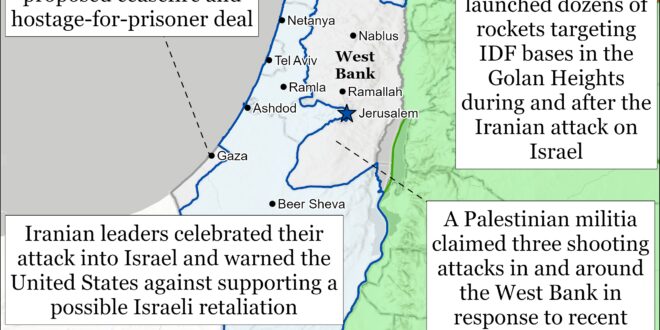Senior Iranian military and political officials praised the alleged success of the April 13 Iranian attack against Israel and simultaneously warned the United States that Iran would target US bases in the region if the US supported an Israeli response.[i] Iranian Armed Forces General Staff (AFGS) Chief Maj. Gen. Mohammad Bagheri warned that, if the United States supports any Israeli response to its attack, Iran will target US bases in the region.[ii] Bagheri further specified that Iran intended to target the IDF Air Force Nevatim airbase in the Negev desert and the IDF intelligence center in Mt. Hermon during the attack against Israel. Iranian missiles caused limited damage to the Nevatim airbase, and the base remains operational.[iii] There are no reports of any damage to the intelligence center in northern Israel. The IRGC issued a warning to the United States not to get involved in a response to the Iranian operation.[iv] Artesh Commander Maj. Gen Abdol Rahim Mousavi stated that, if the United States uses any of its regional bases to support Israel, then Iran will consider the US bases legitimate targets and retaliate accordingly.[v] Iranian President Ebrahim Raisi stated that, if Israel responds to the Iranian operation, Iran will retaliate with greater severity than its April 13 attack.[vi] Raisi emphasized that Israel’s supporters, presumably meaning the United States, should ”appreciate” the ”responsible and propionate” nature of the Iranian April 13 operation.
A senior Iranian military official asserted on April 14 that Iran has adopted a new policy to target Israel directly from Iranian territory due to the “success” of the Iranian attack on Israel.[vii] IRGC Commander Maj. Gen Hossein Salami stated that Iran has adopted a new “equation” for confronting Israel following the “success” of the attack, which Iran dubbed the “True Promise” operation.[viii] Salami warned that, should Israel attack Iran or Iranian targets abroad, Iran will retaliate by launching attacks targeting Israel directly from Iranian territory.[ix] This would represent a significant shift in Iranian policy, where historically Iran has relied on proxy and partners to launch attacks targeting Israel rather than conducting the attacks itself.
Israel and its partners are discussing possible responses to the Iranian attack on Israel. Israeli President Isaac Herzog said that the Iranian attack was “like a declaration of war” but emphasized that Israelis “are not war seekers.”[x] Israeli War Cabinet member Benny Gantz stated that Israel would respond to the attack at a time of its choosing.[xi] Israeli Foreign Affairs Minister Israel Katz stated, “We said that, if Iran attacks Israel, Israel will attack Iran – that is still valid.”[xii] US President Joe Biden told Israeli Prime Minister Benjamin Netanyahu on the night of April 13 in a phone call that the United States will not participate in an offensive response to Iran’s attack.[xiii] Leaders from the Group of 7 nations (G7) convened on April 14 to coordinate a “diplomatic response” to Iran’s attack, according to the White House.[xiv] An unspecified Biden administration official said that the G7 leaders discussed the possibility of recognizing the IRGC as a terrorist organization, which the United States did in 2019.[xv]
Key Takeaways:
- Iran: Senior Iranian military and political officials praised the alleged success of the April 13 Iranian attack against Israel and simultaneously warned the United States that Iran would target US bases in the region if the US supported an Israeli response.
- A senior Iranian military official asserted that Iran has adopted a new policy to target Israel directly from Iranian territory due to the “success” of the Iranian attack on Israel.
- Israel and its partners are discussing possible responses to the Iranian attack on Israel.
- Northern Gaza Strip: Israeli forces continued to clearing operations in Nuseirat along Wadi Gaza.
- Political Negotiations: Hamas rejected a US-proposed ceasefire and hostage-for-prisoner exchange deal.
- West Bank: A Palestinian militia claimed three shooting attacks in and around the West Bank in retaliation for recent settler violence.
- Southern Lebanon and Golan Heights: Lebanese Hezbollah conducted at least four attacks from southern Lebanon into northern Israel during and after the Iranian attack on Israel.
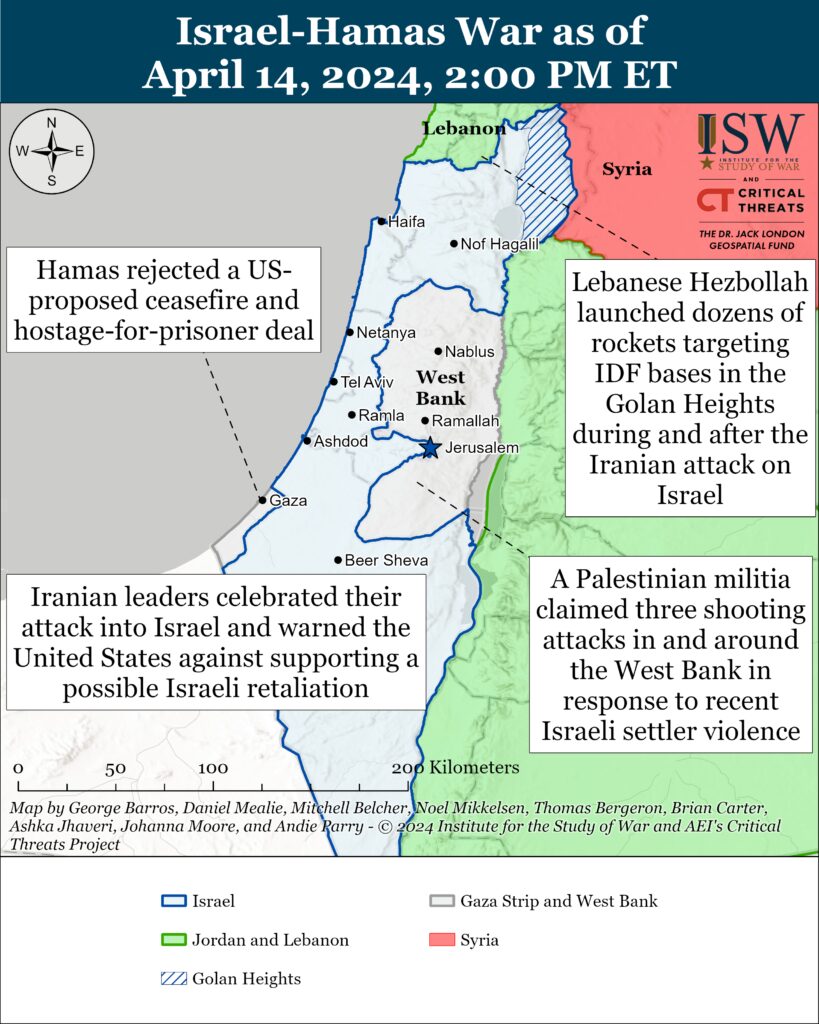
Gaza Strip
Axis of Resistance objectives:
Erode the will of the Israeli political establishment and public to sustain clearing operations in the Gaza Strip
Reestablish Hamas as the governing authority in the Gaza StripIsraeli forces continued to clearing operations in Nuseirat along Wadi Gaza on April 14. Israel Defense Forces (IDF) 401st Brigade combat engineers built two bridges for Israeli tanks to cross Wadi Gaza, a natural separation between the north and south of the Gaza Strip.[xvi] Elements of the IDF 162nd Division, including the Nahal and 401st brigades, are operating in the area to kill Palestinian fighters and destroy military infrastructure.[xvii][xviii] Israeli forces destroyed rocket launch sites in the central Gaza Strip that several Palestinian militias used .[xix] Palestinian fighters had prepared to launch the rockets into Israel. Israeli forces have killed dozens of Palestinian fighters in close-range engagements over the past several days of operations in the Nuseirat area.[xx]
Palestinian fighters claimed a single attack targeting Israeli forces in the Gaza Strip on April 14. The al Aqsa Martyrs’ Brigades, which is the self-proclaimed military wing of Fatah, reported that its fighters mortared Israeli forces north of Nuseirat.[xxi]
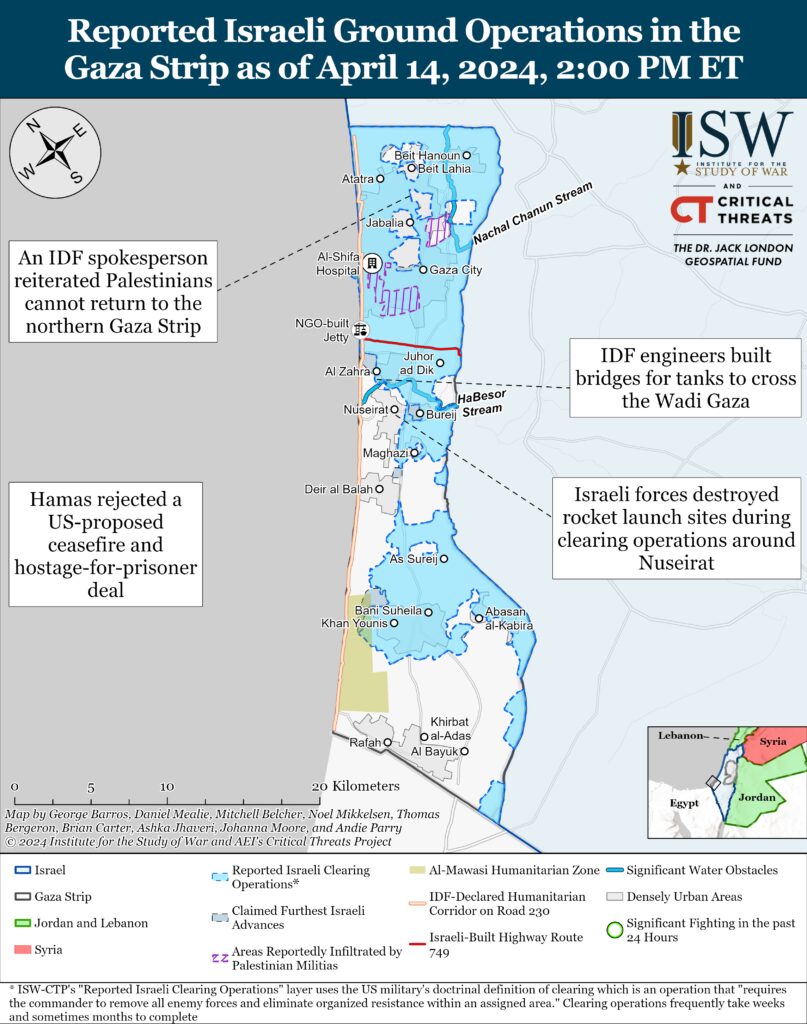
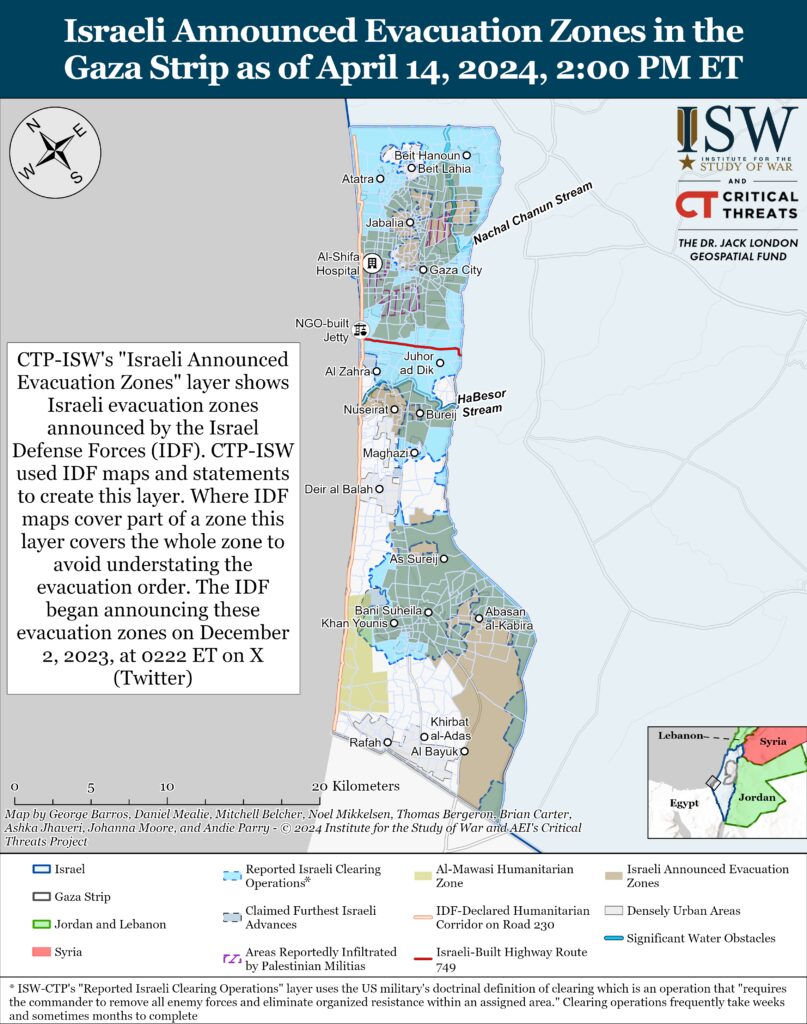
Hamas rejected a US-proposed ceasefire and hostage-for-prisoner exchange deal on April 13.[xxii] The proposal would have reportedly established a six-week ceasefire in exchange for the release of 40 Israeli hostages held by Palestinian militias in the Gaza Strip.[xxiii] Mediators presented Hamas with the US proposal on April 7.[xxiv] Hamas reiterated in its rejection that the group would only accept a ceasefire proposal that includes a permanent ceasefire, the withdrawal of Israeli forces from the entire Gaza Strip, the return of the displaced Palestinians, an increase in the delivery of humanitarian aid to the Gaza Strip, and the start of reconstruction efforts.[xxv] [xxvi] The Israeli Prime Minister’s Office confirmed that Hamas rejected the ceasefire proposal on April 14 and said that the proposal ”included the most significant flexibility on Israel’s part” since the beginning of negotiations.[xxvii]
The IDF Arabic-language spokesperson reiterated on April 14 that Palestinians cannot return to the northern Gaza Strip, calling the area “a war zone.”.[xxviii] The spokesperson specified that Palestinian civilians should not try to migrate to the northern Gaza Strip on the Salah al Din or al Rashid roads despite ”rumors” the IDF is allowing civilians to return.[xxix] Local Palestinian sources posted footage of crowds of Palestinians civilians walking to the northern Gaza Strip on al Rashid Road on April 14 as a munition exploded on near the road.[xxx] Israeli military correspondents previously hypothesized that the recent IDF withdrawal from the southern Gaza Strip would enable displaced Palestinians in Rafah to migrate to parts of Khan Younis and the central Gaza Strip.[xxxi] [xxxii]
Several Palestinian political factions, including Hamas, issued supportive statements of Iran’s April 13 attack on Israel. The groups called the Iranian attack a “natural” and “justified” response to the April 1 Israeli airstrike that targeted Islamic Revolutionary Guards Corps (IRGC) officials in Damascus.[xxxiii] The Popular Front of the Liberation of Palestinian, a secular leftist Palestinian group fighting alongside Hamas in the war, called the Iranian attack an “important turning point“ in the war.[xxxiv]
Palestinian fighters did not conduct any indirect fire attacks from the Gaza Strip into Israel on April 14.
West Bank
Axis of Resistance objectives:
Establish the West Bank as a viable front against IsraelThe al Aqsa Martyrs’ Brigades claimed three shooting attacks on April 13 in and around the West Bank in retaliation for recent settler violence. The al Aqsa Martyrs’ Brigades targeted an Israeli military checkpoint, an Israeli settlement near Tulkarm, and an Israeli town on the border with the West Bank..[xxxv] An Israeli Army Radio West Bank correspondent posted a flyer signed by 11 West Bank Rabbis in response to the death of a 14-year-old boy who was murdered near the Malachi HaShalom settlement on April 12.[xxxvi] The flyer called on Israelis to strengthen and grow settlements across the West Bank in response to the boy’s death. Palestinian media claimed that Israeli settlers have targeted Palestinians in Auja, Huwwara, Jalazoun refugee camp, Kafr Shuba, and Nabe Ghazzal since CTP-ISW’s last data cut off on April 13.[xxxvii] CTP-ISW cannot independently verify these reports.
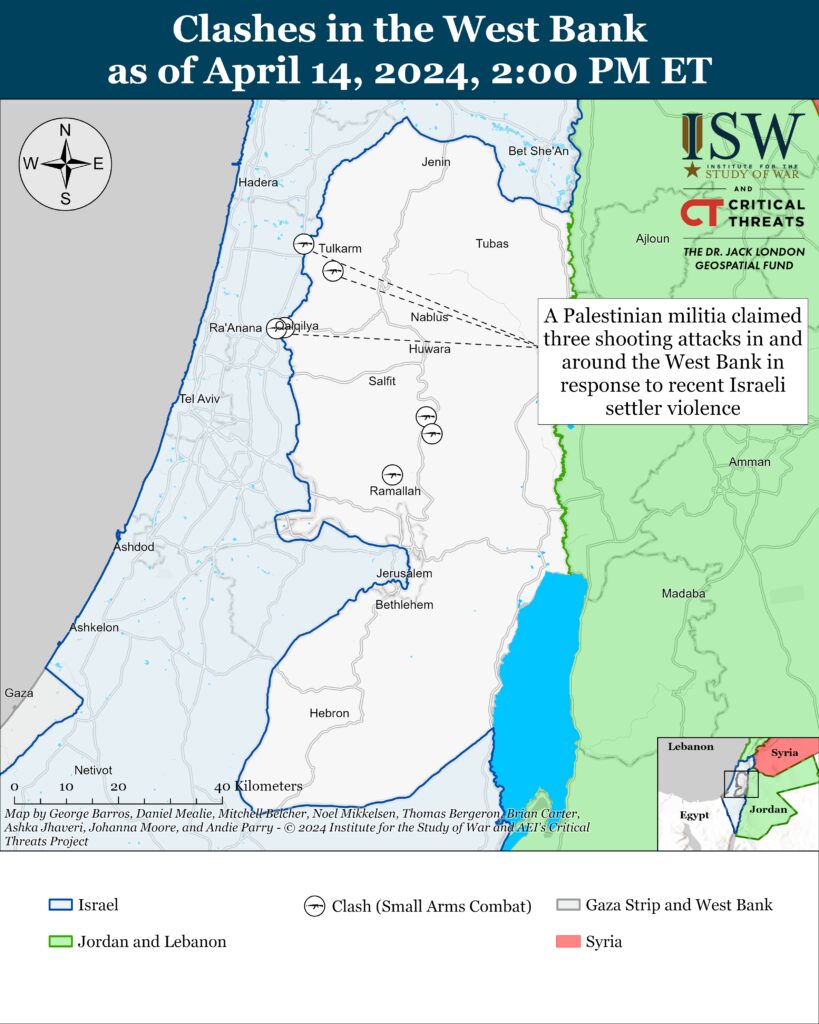
This map is not an exhaustive depiction of clashes and demonstrations in the West Bank.
Southern Lebanon and Golan Heights
Axis of Resistance objectives:
Deter Israel from conducting a ground operation into Lebanon
Prepare for an expanded and protracted conflict with Israel in the near term
Expel the United States from SyriaLebanese Hezbollah conducted at least four attacks from southern Lebanon into northern Israel during and after the Iranian attack on Israel on April 13.[xxxviii]
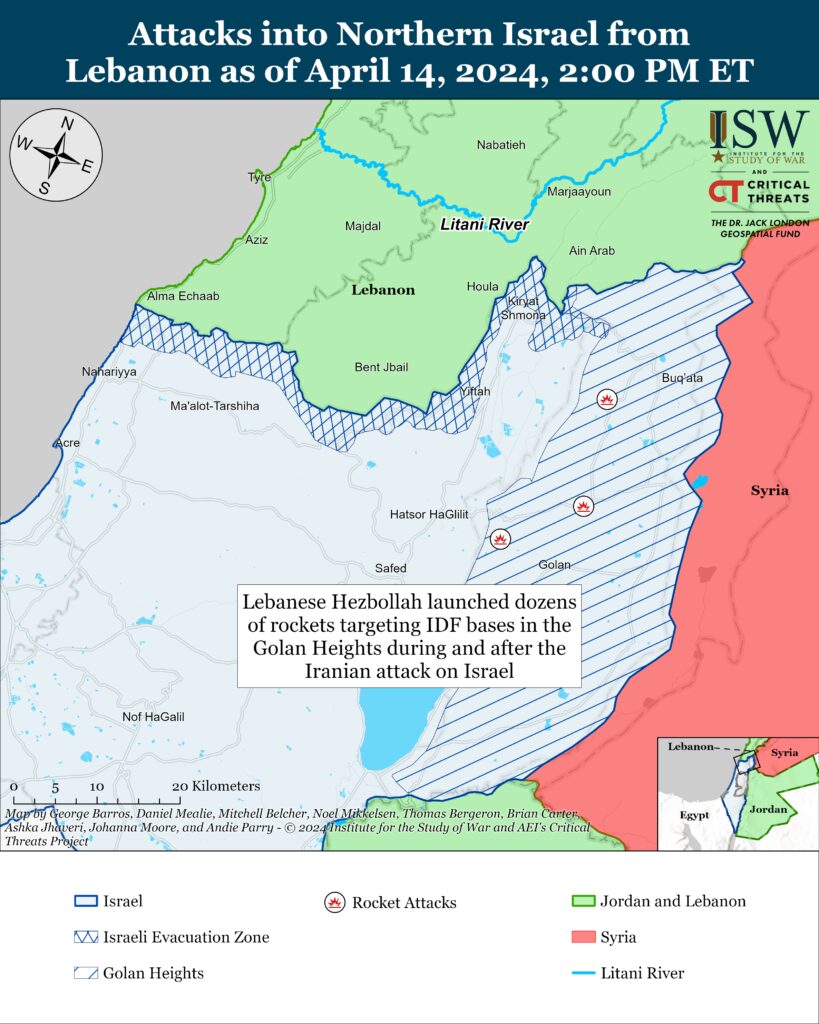
Recorded reports of attacks; CTP-ISW cannot independently verify impact.
 Eurasia Press & News
Eurasia Press & News
